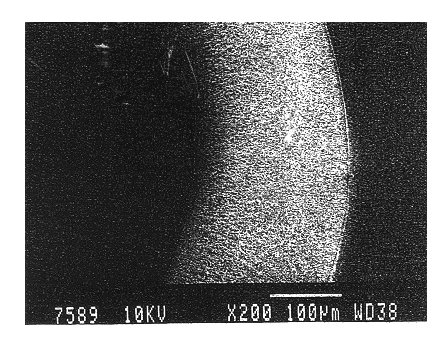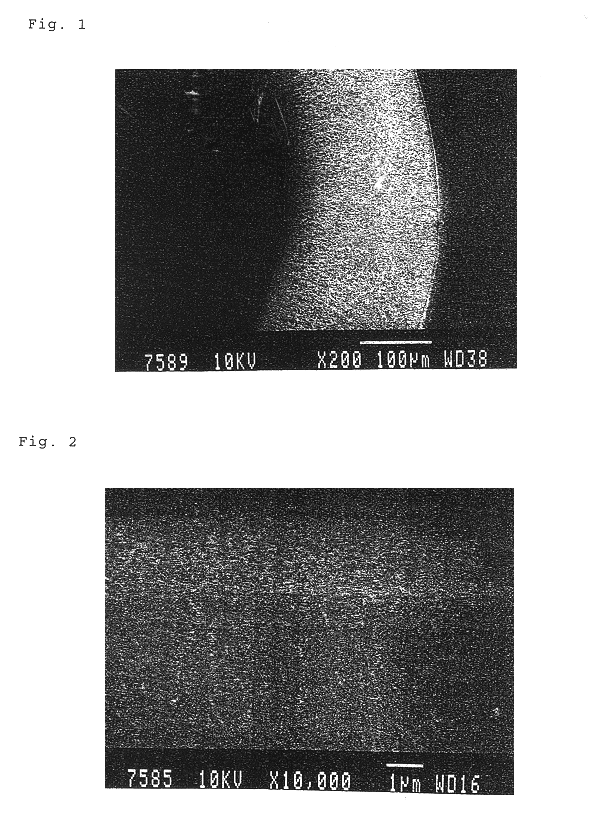Cellulose compound hollow fiber membrane
llulose compound technology, applied in the direction of membranes, filtration separation, separation processes, etc., can solve the problems of generating sterilization byproducts, membranes degraded by microorganisms in raw water, and no prior art specifically describes a hollow fiber membrane exhibiting high water permeation rate and high strength
- Summary
- Abstract
- Description
- Claims
- Application Information
AI Technical Summary
Benefits of technology
Problems solved by technology
Method used
Image
Examples
example 1
A spinning stock solution consisting of 24% by weight of cellulose acetate propionate (degree of substitution: 2.68; number average molecular weight: 75,000; acetyl: 2.5%; and propionyl: 61.2%) and 76% by weight of dimethyl sulfoxide was discharged from an outer pipe of a double pipe type nozzle while water was discharged from an inner pipe of the nozzle as an inside coagulating solution. The temperature of the spinning stock solution at the discharge opening was 70.degree. C. After passing the discharged spinning stock solution through the air for 1 second, it was coagulated in a coagulation water bath (hot water at 70.degree. C.), and then the solvent was completely removed in a washing bath (hot water at 50.degree. C.) to give a hollow fiber membrane. An electron microphotograph (at a magnification of .times.200) of the inside (cross-section) of the hollow fiber membrane is shown in FIG. 1, and an electron microphotograph (at a magnification of .times.10,000) of the internal surf...
example 2
A hollow fiber membrane was obtained in the same manner as in Example 1 except that a spinning stock solution consisting of 24% by weight of cellulose acetate propionate (degree of substitution: 2.68; number average molecular weight: 75,000; acetyl: 2.5%; and propionyl: 61.2%), 75% by weight of dimethyl sulfoxide and 1% by weight of polyethylene glycol (manufactured by Sanyo Chemical Industries, Ltd., PEG200) was used. A cross-section of this hollow fiber membrane had a three-dimensional network-like porous structure with a dense structure in the internal and external surfaces thereof. Each value in the structure of the hollow fiber membrane and the test results are shown in Table 1.
example 3
A hollow fiber membrane was obtained in the same manner as in Example 1 except that a spinning stock solution consisting of 22% by weight of cellulose acetate propionate (degree of substitution: 2.68; number average molecular weight: 75,000; acetyl: 2.5%; and propionyl: 61.2%), 77% by weight of dimethyl sulfoxide and 1% by weight of lithium chloride (manufactured by Wako Pure Chemical Industries, Ltd.) was used. A cross-section of the hollow fiber membrane had a three-dimensional network-like porous structure with a dense structure in the internal and external surfaces thereof. Each value in the structure of the hollow fiber membrane and the test results are shown in Table 1.
PUM
| Property | Measurement | Unit |
|---|---|---|
| Percent by mass | aaaaa | aaaaa |
| Pressure | aaaaa | aaaaa |
| Angle | aaaaa | aaaaa |
Abstract
Description
Claims
Application Information
 Login to View More
Login to View More - R&D
- Intellectual Property
- Life Sciences
- Materials
- Tech Scout
- Unparalleled Data Quality
- Higher Quality Content
- 60% Fewer Hallucinations
Browse by: Latest US Patents, China's latest patents, Technical Efficacy Thesaurus, Application Domain, Technology Topic, Popular Technical Reports.
© 2025 PatSnap. All rights reserved.Legal|Privacy policy|Modern Slavery Act Transparency Statement|Sitemap|About US| Contact US: help@patsnap.com



